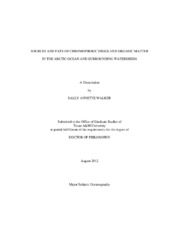| dc.contributor.advisor | Amon, Rainer M. | |
| dc.creator | Walker, Sally Annette | |
| dc.date.accessioned | 2012-10-19T15:30:05Z | |
| dc.date.accessioned | 2012-10-22T18:02:08Z | |
| dc.date.available | 2014-11-03T19:49:15Z | |
| dc.date.created | 2012-08 | |
| dc.date.issued | 2012-10-19 | |
| dc.date.submitted | August 2012 | |
| dc.identifier.uri | https://hdl.handle.net/1969.1/ETD-TAMU-2012-08-11527 | |
| dc.description.abstract | Given the pace of climate change in the Arctic, it is vital to better constrain terrigenous dissolved organic matter (tDOM) fluctuations in large Arctic Rivers and the role that climate change may bring to tDOM inputs into the Arctic Ocean and to the global carbon cycle. This project uses the optical properties of chromophoric dissolved organic matter (CDOM) to investigate the quality, quantity and fate of dissolved organic matter (DOM) in large Arctic Rivers and the interior Arctic Basin. In large rivers surrounding the Arctic, peak discharge CDOM is largely derived from fresh terrestrial plant material whereas during base flow the CDOM pool has a greater microbial imprint, particularly in the Mackenzie. The higher microbial imprint in the Mackenzie can be explained by longer water residence times, which may be important in a warming climate where increased precipitation rates will likely lead to increased hydrological connectivity and therefore longer water residence times. In surface waters of the Canadian Archipelago, 17 % of the DOM pool is of terrestrial origin, even though waters are diluted with sea ice melt, suggesting the likelihood of a subsurface plume of tDOM entrained within river runoff from Arctic Rivers. In the interior Arctic, an elevated terrestrial CDOM signal in the Eurasian Basin (EB) points to the presence of Eurasian river CDOM entrained within river runoff in the Transpolar Drift. In contrast, autochthonous/microbial CDOM sources become more important the Canadian Basin (CB) and the terrestrial CDOM signal is much lower relative to the EB.
A good constraint on the nature and distributions of freshwater (FW) in the Arctic Ocean is paramount to understand the role climate change may play for the Arctic’s hydrological cycle. During this study, we used the spatial patterns of terrestrially derived CDOM to better understand the distribution and nature of river runoff across the upper Arctic Basin. This study illustrates the usefulness of CDOM to finger-print water masses within the Arctic Ocean and shows promise to improve our understanding of upper Arctic Ocean ventilation patterns. | en |
| dc.format.mimetype | application/pdf | |
| dc.language.iso | en_US | |
| dc.subject | Arctic Ocean | en |
| dc.subject | Carbon cycling in the Arctic region | en |
| dc.subject | CDOM | en |
| dc.subject | The use of CDOM as a tracer | en |
| dc.title | Sources and Fate of Chromophoric Dissolved Organic Matter in the Arctic Ocean and Surrounding Watersheds | en |
| dc.type | Thesis | en |
| thesis.degree.department | Oceanography | en |
| thesis.degree.discipline | Oceanography | en |
| thesis.degree.grantor | Texas A&M University | en |
| thesis.degree.name | Doctor of Philosophy | en |
| thesis.degree.level | Doctoral | en |
| dc.contributor.committeeMember | Bianchi, Thomas | |
| dc.contributor.committeeMember | Louchouarn, Patrick | |
| dc.contributor.committeeMember | Orsi, Alejandro | |
| dc.type.genre | thesis | en |
| dc.type.material | text | en |
| local.embargo.terms | 2014-10-22 | |


